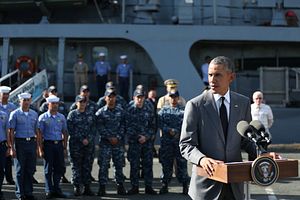An already growing security alliance between the Philippines and the United States received a huge boost when the Philippine Supreme Court cleared a legal obstacle to the implementation of the Enhanced Defense Cooperation Agreement (EDCA). For about a year, the new agreement, which was signed shortly before U.S. President Barack Obama’s visit to the Philippines in mid-2014, was stuck in a constitutional limbo.
The Philippine Senate had adamantly demanded that the EDCA go through the ratification process, deeming it as a treaty agreement that mandates the concurrence of the upper chamber. Meanwhile, progressive groups challenged the constitutionality of the new security agreement, characterizing it as an affront to the Philippines’ national sovereignty. After extensive deliberations, members of the country’s highest court overwhelmingly (10-4) voted in favor of EDCA’s implementation.
The agreement paves the way for a massive increase in the American military footprint on Philippine soil, particularly across a series of much-prized bases, some of which are close to the South China Sea. Yet there is no assurance that this will significantly enhance Manila’s hands in the disputed waters. If anything, the regional maritime disputes could get even more complicated as two superpowers, China and the United States, move dangerously close to each other.
Much ado about nothing
One of the biggest misconceptions about the EDCA is that it paves the way for the re-establishment of U.S. military bases in the Philippines. Even the organizers of the Miss Universe contest seem to have fallen for this mischaracterization. A closer look at the agreement actually reveals that we are instead looking at a new generation of American overseas military access.
The EDCA provides U.S. forces rotational, negotiated, and limited access to a number of mutually-agreed upon locations. So far, the Americans have zeroed in on at least eight prime military bases, including Subic and Clark — the site of largest American military bases during Cold War — as well as Oyster Bay in Palawan, strategically close to disputed land features and waters in the South China Sea.
Instead of permanent U.S. bases, we are instead looking at the establishment of forward operating sites and cooperative security locations, where the host nation (theoretically) enjoys considerable supervision and control over the activities of visiting forces. The EDCA is particularly beneficial to the United States, because it will no longer have to pay huge sums to rent out Filipino bases à la Cold War days, not to mention that the Philippines will actually end up paying for the transportation and utility costs of visiting forces.
In short, the Pentagon will enjoy low-cost and flexible access to premium locations in the Philippines. So what is the Philippines is getting in exchange? There is nothing in the EDCA that compels the United States to come to the host nation’s rescue as far as Sino-Philippine territorial disputes are concerned. The Obama administration has consistently reiterated that the agreement is not aimed at China, but instead is aimed at enhancing the two allies’ capabilities in the realm of humanitarian relief and disaster-management operations.
A gray area in the alliance
A cursory look at Washington’s diplomatic position reveals that throughout the past decades, various U.S. administrations refused to clarify whether the U.S.-Philippine Mutual Defense Treaty (MDT) will be applied in the event of a conflict over Philippine-claimed/occupied territories in the South China Sea.
No less than Henry Kissinger, in a diplomatic cable, made it clear that “there are substantial doubts that [Philippine] military contingent on island in the Spratly group would come within protection of (MDT),” limiting America to offering only “helpful political actions” in an event of emergency. Unless the Philippines and other claimant states legally and/or diplomatically settled their disputes, Kissinger notes, “[we] do not see legal basis at this time, however, for supporting the claim to Spratlys of one country over that of other claimants.”
This is the bedrock of the Obama administration’s policy of neutrality vis-à-vis sovereignty disputed in the South China Sea, although the United States has effectively negated Chinese claims over certain low-tide elevations by conducting Freedom of Navigation (FON) operations within their 12 nautical miles radius. The Philippines’ ongoing arbitration case against China, meanwhile, isn’t expected to definitively resolve the sovereignty-related aspects of their maritime disputes, since the United Nations Convention on the Law of the Sea has no jurisdiction over such concerns.
The Philippines, however, hopes that an increased U.S. military footprint on its soil will nonetheless provide some element of ‘latent deterrence’ against further Chinese provocations. Although legally not obligated to do so, Washington will surely come under tremendous political pressure to help the Philippines in an event of contingency in the disputed waters. Furthermore, EDCA facilitates the expansion of joint military exercises, the enhancement of interoperability among the two allies, and the transfer of more U.S. funds and military equipment to Armed Forces of the Philippines.
The two allies are also looking at the possibility of conducting joint FON patrols in the contested waters, both negating Chinese claims over certain land features as well as pushing back against Beijing’s purported efforts at restraining freedom of navigation and overflight in the area. As evident in Chinese state-owned media’s fiery rhetoric, Beijing sees the EDCA as nothing but a springboard for greater U.S. interference vis-à-vis the South China Sea disputes.
Anticipating a growing American military presence in the area, China could very well respond by accelerating its construction activities in the disputed features, stepping up its para-military and military patrols, and augmenting its own military footprint in the area. The stage is set for a new phase of Sino-American rivalry in the region.
Richard J. Heydarian teaches political science at De La Salle University, the Philippines, and is the author of Asia’s New Battlefield: US, China, and the Struggle for Western Pacific (Zed, London).

































